Writers Read Better: Nonfiction: 50+ Paired Lessons That Turn Writing Craft Work Into Powerful Genre Reading: Corwin Literacy
Autor M. Colleen Cruzen Limba Engleză Paperback – 21 oct 2018
Din seria Corwin Literacy
-
 Preț: 285.18 lei
Preț: 285.18 lei -
 Preț: 158.08 lei
Preț: 158.08 lei -
 Preț: 278.39 lei
Preț: 278.39 lei -
 Preț: 243.82 lei
Preț: 243.82 lei -
 Preț: 244.25 lei
Preț: 244.25 lei -
 Preț: 88.42 lei
Preț: 88.42 lei -
 Preț: 273.64 lei
Preț: 273.64 lei -
 Preț: 274.70 lei
Preț: 274.70 lei -
 Preț: 200.91 lei
Preț: 200.91 lei -
 Preț: 248.26 lei
Preț: 248.26 lei -
 Preț: 284.26 lei
Preț: 284.26 lei -
 Preț: 294.79 lei
Preț: 294.79 lei -
 Preț: 281.36 lei
Preț: 281.36 lei -
![Mindsets and Moves: Strategies That Help Readers Take Charge [Grades K-8]](https://i3.books-express.ro/bs/9781506314938/mindsets-and-moves.jpg) Preț: 156.17 lei
Preț: 156.17 lei -
 Preț: 283.27 lei
Preț: 283.27 lei -
 Preț: 88.42 lei
Preț: 88.42 lei -
 Preț: 281.94 lei
Preț: 281.94 lei -
 Preț: 248.26 lei
Preț: 248.26 lei -
 Preț: 278.64 lei
Preț: 278.64 lei -
 Preț: 267.50 lei
Preț: 267.50 lei -
 Preț: 237.15 lei
Preț: 237.15 lei -
 Preț: 270.76 lei
Preț: 270.76 lei -
![Comprehension [Grades K-12]: The Skill, Will, and Thrill of Reading](https://i3.books-express.ro/bs/9781071812839/comprehension-grades-k-12.jpg) Preț: 287.79 lei
Preț: 287.79 lei -
 Preț: 278.10 lei
Preț: 278.10 lei -
 Preț: 245.45 lei
Preț: 245.45 lei -
 Preț: 204.26 lei
Preț: 204.26 lei -
 Preț: 272.62 lei
Preț: 272.62 lei -
![Every Minute Matters [Grades K-5]: 40+ Activities for Literacy-Rich Classroom Transitions](https://i4.books-express.ro/bs/9781544382449/every-minute-matters-grades-k-5.jpg) Preț: 193.61 lei
Preț: 193.61 lei -
 Preț: 274.00 lei
Preț: 274.00 lei -
![Flash Feedback [Grades 6-12]: Responding to Student Writing Better and Faster – Without Burning Out](https://i4.books-express.ro/bs/9781544360492/flash-feedback-grades-6-12.jpg) Preț: 232.71 lei
Preț: 232.71 lei -
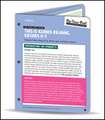 Preț: 88.67 lei
Preț: 88.67 lei -
 Preț: 147.92 lei
Preț: 147.92 lei -
 Preț: 273.44 lei
Preț: 273.44 lei -
 Preț: 184.56 lei
Preț: 184.56 lei -
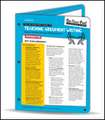 Preț: 88.67 lei
Preț: 88.67 lei -
 Preț: 236.11 lei
Preț: 236.11 lei -
 Preț: 209.15 lei
Preț: 209.15 lei -
 Preț: 256.83 lei
Preț: 256.83 lei -
 Preț: 291.04 lei
Preț: 291.04 lei -
 Preț: 288.67 lei
Preț: 288.67 lei -
 Preț: 273.44 lei
Preț: 273.44 lei -
 Preț: 278.10 lei
Preț: 278.10 lei -
 Preț: 244.44 lei
Preț: 244.44 lei -
![Mentor Texts That Multitask [Grades K-8]: A Less-Is-More Approach to Integrated Literacy Instruction](https://i3.books-express.ro/bs/9781071836132/mentor-texts-that-multitask-grades-k-8.jpg) Preț: 241.23 lei
Preț: 241.23 lei -
 Preț: 140.61 lei
Preț: 140.61 lei -
 Preț: 216.22 lei
Preț: 216.22 lei -
 Preț: 218.84 lei
Preț: 218.84 lei -
 Preț: 277.50 lei
Preț: 277.50 lei -
 Preț: 273.44 lei
Preț: 273.44 lei
Preț: 174.52 lei
Nou
Puncte Express: 262
Preț estimativ în valută:
33.39€ • 34.87$ • 27.64£
33.39€ • 34.87$ • 27.64£
Carte disponibilă
Livrare economică 15-29 martie
Livrare express 01-07 martie pentru 101.48 lei
Preluare comenzi: 021 569.72.76
Specificații
ISBN-13: 9781506311234
ISBN-10: 1506311237
Pagini: 248
Dimensiuni: 187 x 232 x 13 mm
Greutate: 0.5 kg
Ediția:1
Editura: SAGE Publications
Colecția Corwin
Seria Corwin Literacy
Locul publicării:Thousand Oaks, United States
ISBN-10: 1506311237
Pagini: 248
Dimensiuni: 187 x 232 x 13 mm
Greutate: 0.5 kg
Ediția:1
Editura: SAGE Publications
Colecția Corwin
Seria Corwin Literacy
Locul publicării:Thousand Oaks, United States
Recenzii
Lots of books teach us the reasons why writing matters, yet Colleen adds a new reason to the list: Writing can be a lever that lifts our kids' reading work. And that can happen even when kids are not writing about reading, but are, instead, doing their own important writing work. Once again, Colleen nudges us forward.
Colleen offers literacy teachers a valuable comprehension instruction ‘hack’: help students get inside the brains of the writers they read by doing the same kind of writing themselves before they read. She argues convincingly that the more students understand how something was made, the better they’ll understand it when they encounter it as readers. She doesn’t just offer compelling research to prove it; she offers teachers dozens of paired lessons so that students will read and write information texts with more power. The lessons are streamlined to allow students maximum time for practice and application, and to help the busy teacher go from the page to the classroom quickly and almost effortlessly. I encourage all upper elementary and middle school teachers to give these lesson sets a try!
Most professional books on teaching nonfiction focus on teaching writing or reading, but not both. In this unique book, Colleen Cruz shows us how to teach complementary writing and reading lessons that will help students use what they’re learning about nonfiction writing to help them become more powerful nonfiction readers
.
This book refuels your energy to think about the way you plan and teach reading and writing. Colleen holds strong to the tenets of workshop—choice, voice, and agency—then beautifully blends the lessons and theory with her vast experience in classrooms, new research on writing and reading, and the dance we do with it all now in the digital world. The structure of the book and the lessons are completely accessible for all teachers, the way Colleen believes the learning and craft to be accessible for all students. It’s a gamechanger for those looking to augment and reflect on their current workshop model and for those who are going to give it a go. Colleen is with you every step of the way.
Colleen offers literacy teachers a valuable comprehension instruction ‘hack’: help students get inside the brains of the writers they read by doing the same kind of writing themselves before they read. She argues convincingly that the more students understand how something was made, the better they’ll understand it when they encounter it as readers. She doesn’t just offer compelling research to prove it; she offers teachers dozens of paired lessons so that students will read and write information texts with more power. The lessons are streamlined to allow students maximum time for practice and application, and to help the busy teacher go from the page to the classroom quickly and almost effortlessly. I encourage all upper elementary and middle school teachers to give these lesson sets a try!
Most professional books on teaching nonfiction focus on teaching writing or reading, but not both. In this unique book, Colleen Cruz shows us how to teach complementary writing and reading lessons that will help students use what they’re learning about nonfiction writing to help them become more powerful nonfiction readers
.
This book refuels your energy to think about the way you plan and teach reading and writing. Colleen holds strong to the tenets of workshop—choice, voice, and agency—then beautifully blends the lessons and theory with her vast experience in classrooms, new research on writing and reading, and the dance we do with it all now in the digital world. The structure of the book and the lessons are completely accessible for all teachers, the way Colleen believes the learning and craft to be accessible for all students. It’s a gamechanger for those looking to augment and reflect on their current workshop model and for those who are going to give it a go. Colleen is with you every step of the way.
Cuprins
List of Videos
Acknowledgments
Introduction
How to Use This Book
PART 1. LESSONS FOR GENERATING IDEAS—AND INTERPRETING AUTHOR’S PURPOSE
What You Will Find in This Section
When to Use These Lessons
Preparing to Use the Lessons
LESSON 1
Writing: An Author’s Expertise Matters
Reading: Considering the Source
LESSON 2
Writing: Write About What You Take for Granted
Reading: Learning Unexpected Things From Familiar Topics
LESSON 3
Writing: The Relationship Between an Author’s Passions and Stance
Reading: Identifying an Author’s Stance
LESSON 4
Writing: Narrowing Down a Broad Topic
Reading: Understanding Topics and Subtopics
LESSON 5
Writing: The Role of Structure in Informational Texts
Reading: Considering How Choices in Structure Affect Meaning
LESSON 6
Writing: Using Structure to Convey the Writer’s Intent
Reading: Inferring the Author’s Intent by Noticing Structure
FOR DIGITAL CLASSROOMS
Writing: Choosing the Best Platform for Your Information and Audience
Reading: Considering Why Authors Might Choose Analogue or Digital Mediums
PART 2. LESSONS FOR DRAFTING—AND UNDERSTANDING AUTHOR’S CRAFT
What You Will Find in This Section
When to Use These Lessons
Preparing to Use the Lessons
LESSON 7
Writing: Drafting What You’re Most Ready to Write
Reading: Spotting What’s Most Important to an Author
LESSON 8
Writing: Structure Within Sections: Stacking Information
Reading: Identifying the Way Information Is Stacked
LESSON 9
Writing: Drafting With Placeholders for Later Facts
Reading: Using Jots to Note Facts Quickly
LESSON 10
Writing: Taking a Draft Break to Research
Reading: Noticing the Various Ways Authors Use Quotation Marks
LESSON 11
Writing: Drafting With an Audience in Mind
Reading: Noticing the Different Genres of Various Publications on the Same Topic
LESSON 12
Writing: Drafting in a Mood or Tone That Matches the Content
Reading: Noticing When the Tone Doesn’t Match the Topic
LESSON 13
Writing: Drafting to Someone Else’s Specifications
Reading: Noticing a Publisher’s Approach
FOR DIGITAL CLASSROOMS
Writing: Fact-Checking Digital Information for Accuracy
Reading: Identifying False Information
PART 3. LESSONS FOR REVISING FOR POWER, CRAFT, ANALYSIS, AND CRITIQUE
What You Will Find in This Section
When to Use These Lessons
Preparing to Use the Lessons
LESSON 14
Writing: Deciding What’s Most Important to Revise
Reading: Identifying and Questioning the Author’s Values
LESSON 15
Writing: Reordering Information With Intention
Reading: Noticing the Effect of Information’s Placement
LESSON 16
Writing: Exploring How Writers Weight Information to Signal Import
Reading: Looking at Texts to See How Volume Can Signify Importance
LESSON 17
Writing: The Power of Story
Reading: Switching Strategies When Authors Use Story in Expository Text
LESSON 18
Writing: Connections and Disconnections Across Paragraphs and Pages
Reading: Tracing Connections and Disconnections in Transitions
LESSON 19
Writing: Vocabulary’s Starring Role in Informational Texts
Reading: Expecting and Responding to the Subject’s Vocabulary
LESSON 20
Writing: The Slipperiness of Facts
Reading: Reading With Eyes Wide Open for Bias
FOR DIGITAL CLASSROOMS
Writing: Adding Dimensions to Writing Through Multimodal Features
Reading: Multimodal Readers Prioritize Synthesis
PART 4. LESSONS TO PREPARE FOR PUBLICATION AND THE SCHOLARLY STUDY OF TEXTS
What You Will Find in This Section
When to Use These Lessons
Preparing to Use These Lessons
LESSON 21
Writing: First and Last Words: Intros and Conclusions That Attract and Linger
Reading: Studying an Author’s First and Last Words
LESSON 22
Writing: Choosing When to Quote, Describe, or Summarize
Reading: Identifying Sources and Considering Their Reliability
LESSON 23
Writing: Creating Text Features to Enhance and Add Information
Reading: Integrating Text Features Within and Across Texts
LESSON 24
Writing: Creating Strong Titles and Subtitles
Reading: Titles and Subtitles That Convey Meaning
LESSON 25
Writing: The Many Purposes of Paragraphs
Reading: Seeing Paragraphs as an Author’s Organizational Tool
LESSON 26
Writing: Punctuating With Intention
Reading: Looking Across Texts With an Eye to Punctuation
LESSON 27
Writing: Using Meaning to Make Smart Spelling Decisions
Reading: The Role of Etymology for Readers
LESSON 28
Writing: Making Publishing Decisions Based on the Intended Audience
Reading: Judging the Effectiveness of an Author’s Decisions
FOR DIGITAL CLASSROOMS
Writing: Opening and Maintaining a Conversation With Audiences
Reading: Responding Digitally to the Texts to Deepen Understanding
Publisher’s Acknowledgments
Resources
References
Index
Acknowledgments
Introduction
How to Use This Book
PART 1. LESSONS FOR GENERATING IDEAS—AND INTERPRETING AUTHOR’S PURPOSE
What You Will Find in This Section
When to Use These Lessons
Preparing to Use the Lessons
LESSON 1
Writing: An Author’s Expertise Matters
Reading: Considering the Source
LESSON 2
Writing: Write About What You Take for Granted
Reading: Learning Unexpected Things From Familiar Topics
LESSON 3
Writing: The Relationship Between an Author’s Passions and Stance
Reading: Identifying an Author’s Stance
LESSON 4
Writing: Narrowing Down a Broad Topic
Reading: Understanding Topics and Subtopics
LESSON 5
Writing: The Role of Structure in Informational Texts
Reading: Considering How Choices in Structure Affect Meaning
LESSON 6
Writing: Using Structure to Convey the Writer’s Intent
Reading: Inferring the Author’s Intent by Noticing Structure
FOR DIGITAL CLASSROOMS
Writing: Choosing the Best Platform for Your Information and Audience
Reading: Considering Why Authors Might Choose Analogue or Digital Mediums
PART 2. LESSONS FOR DRAFTING—AND UNDERSTANDING AUTHOR’S CRAFT
What You Will Find in This Section
When to Use These Lessons
Preparing to Use the Lessons
LESSON 7
Writing: Drafting What You’re Most Ready to Write
Reading: Spotting What’s Most Important to an Author
LESSON 8
Writing: Structure Within Sections: Stacking Information
Reading: Identifying the Way Information Is Stacked
LESSON 9
Writing: Drafting With Placeholders for Later Facts
Reading: Using Jots to Note Facts Quickly
LESSON 10
Writing: Taking a Draft Break to Research
Reading: Noticing the Various Ways Authors Use Quotation Marks
LESSON 11
Writing: Drafting With an Audience in Mind
Reading: Noticing the Different Genres of Various Publications on the Same Topic
LESSON 12
Writing: Drafting in a Mood or Tone That Matches the Content
Reading: Noticing When the Tone Doesn’t Match the Topic
LESSON 13
Writing: Drafting to Someone Else’s Specifications
Reading: Noticing a Publisher’s Approach
FOR DIGITAL CLASSROOMS
Writing: Fact-Checking Digital Information for Accuracy
Reading: Identifying False Information
PART 3. LESSONS FOR REVISING FOR POWER, CRAFT, ANALYSIS, AND CRITIQUE
What You Will Find in This Section
When to Use These Lessons
Preparing to Use the Lessons
LESSON 14
Writing: Deciding What’s Most Important to Revise
Reading: Identifying and Questioning the Author’s Values
LESSON 15
Writing: Reordering Information With Intention
Reading: Noticing the Effect of Information’s Placement
LESSON 16
Writing: Exploring How Writers Weight Information to Signal Import
Reading: Looking at Texts to See How Volume Can Signify Importance
LESSON 17
Writing: The Power of Story
Reading: Switching Strategies When Authors Use Story in Expository Text
LESSON 18
Writing: Connections and Disconnections Across Paragraphs and Pages
Reading: Tracing Connections and Disconnections in Transitions
LESSON 19
Writing: Vocabulary’s Starring Role in Informational Texts
Reading: Expecting and Responding to the Subject’s Vocabulary
LESSON 20
Writing: The Slipperiness of Facts
Reading: Reading With Eyes Wide Open for Bias
FOR DIGITAL CLASSROOMS
Writing: Adding Dimensions to Writing Through Multimodal Features
Reading: Multimodal Readers Prioritize Synthesis
PART 4. LESSONS TO PREPARE FOR PUBLICATION AND THE SCHOLARLY STUDY OF TEXTS
What You Will Find in This Section
When to Use These Lessons
Preparing to Use These Lessons
LESSON 21
Writing: First and Last Words: Intros and Conclusions That Attract and Linger
Reading: Studying an Author’s First and Last Words
LESSON 22
Writing: Choosing When to Quote, Describe, or Summarize
Reading: Identifying Sources and Considering Their Reliability
LESSON 23
Writing: Creating Text Features to Enhance and Add Information
Reading: Integrating Text Features Within and Across Texts
LESSON 24
Writing: Creating Strong Titles and Subtitles
Reading: Titles and Subtitles That Convey Meaning
LESSON 25
Writing: The Many Purposes of Paragraphs
Reading: Seeing Paragraphs as an Author’s Organizational Tool
LESSON 26
Writing: Punctuating With Intention
Reading: Looking Across Texts With an Eye to Punctuation
LESSON 27
Writing: Using Meaning to Make Smart Spelling Decisions
Reading: The Role of Etymology for Readers
LESSON 28
Writing: Making Publishing Decisions Based on the Intended Audience
Reading: Judging the Effectiveness of an Author’s Decisions
FOR DIGITAL CLASSROOMS
Writing: Opening and Maintaining a Conversation With Audiences
Reading: Responding Digitally to the Texts to Deepen Understanding
Publisher’s Acknowledgments
Resources
References
Index
Notă biografică
Colleen Cruz is the author of several titles for teachers, includingThe Unstoppable Writing Teacher,as well as the author of the young adult novel,Border Crossing,a Tomás Rivera Mexican American Children¿s Book Award Finalist. She was a classroom teacher in general education and inclusive settings before joining the Teachers College Reading and Writing Project, where she shares her passion for accessibility, twenty-first century learning, and social justice as the Director of Innovation.
Descriere
By flipping the traditional "reading first, writing second" sequence, this innovative book lets teachers make the most of the writing-to-reading connection via 30 carefully matched lesson pairs.
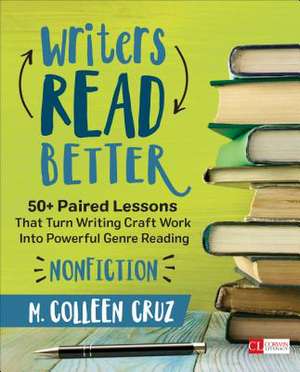


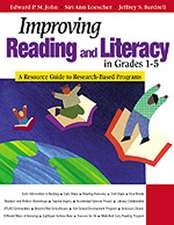
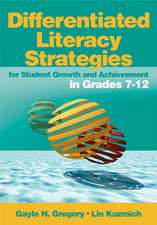


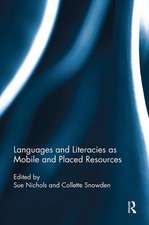
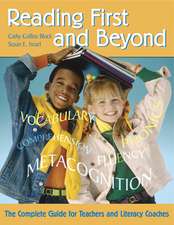

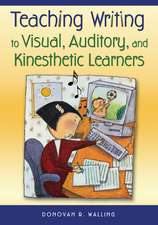
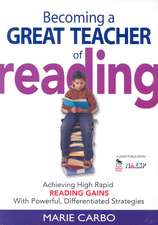

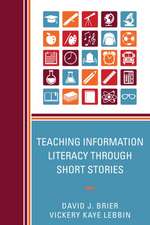





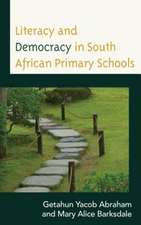
![Every Minute Matters [Grades K-5]: 40+ Activities for Literacy-Rich Classroom Transitions](https://i4.books-express.ro/bt/9781544382449/every-minute-matters-grades-k-5.jpg)

